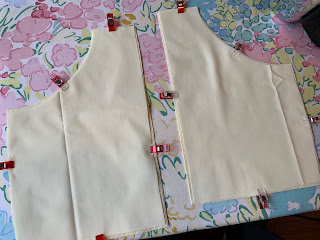 |
| Finished bag hanging from Necchi |
Guest post by Courtney’s mother Linda
Children have an attraction to new and different tools, and big looms threaded with bright colors are a child magnet. Most of my looms are too big for a small person to handle. We made do sometimes with one child on one side of the loom throwing the shuttle to a sibling on the other side with me doing the treadling, but it was obvious to me that they needed a loom to fit. (It didn’t hurt that the little Schacht Wolf Pup was a loom I wanted anyway.)
Enter the four-shaft, six-treadle Wolf Pup. When this photo was taken, Oliver was six and Etta was four, and they could both manage to change the sheds and throw the shuttle themselves.
 |
| Etta and Oliver at the loom |
When baby brother Finn was born, we decided to weave him a playmat. It would have to be three segments sewn together, because the width of the Wolf Pup is only around eighteen inches. I warped it with brightly colored 8/4 cotton and we used white cotton flake for the weft. Predictably, by the time the fabric was completely woven, Finn was walking and had no real need for a playmat. Cotton fabric is versatile—I thought it would make a useful tote bag. I have several bag patterns in my stash, this Simplicity one is from 1975.
 |
| Pattern Envelope |
I sewed three segments together to make the body of the bag. Since the fabric was somewhat loosely woven, I interfaced it with an iron-on product.
 |
| Interfaced section on cutting table |
The weave structure is a simple plain weave, but the irregularity of the cotton flake weft yarn combined with the shrinkage that occurs with cotton yarns when they are washed in hot water has yielded a lovely texture.
 |
| All the pieces cut |
Most of the bag was sewn on my vintage Necchi BU Nova. Listening to that quiet and powerful motor is pure pleasure.
 |
| Green straps being sewn on the Necchi |
Here is the bag mostly constructed, just waiting for the side seams.
 |
| Constructed bag lying flat |
I switched machines to sew the side seams. I wanted the stripes to match at the sides, and the walking foot on my Bernina 1130 keeps the top and bottom layers well matched.
 |
| Side seam sewn on Bernina 1130 |
The bag is lined with a pale yellow cotton, courtesy of my quilting stash. I don’t know what it will store—groceries, toys, beach items—but I hope it will be an incentive for more weaving!
 |
| Perfect pattern matching on the pocket |












































